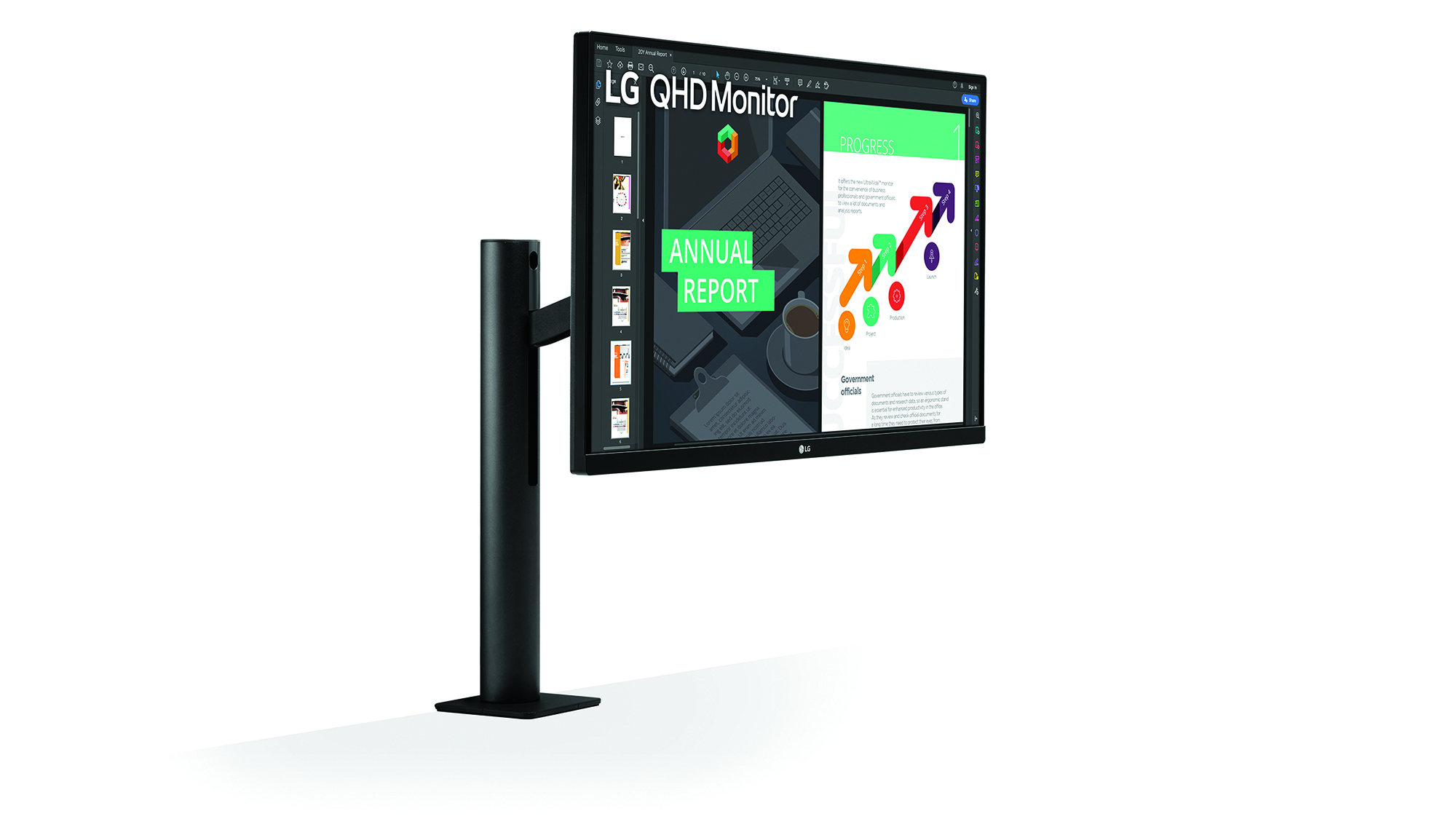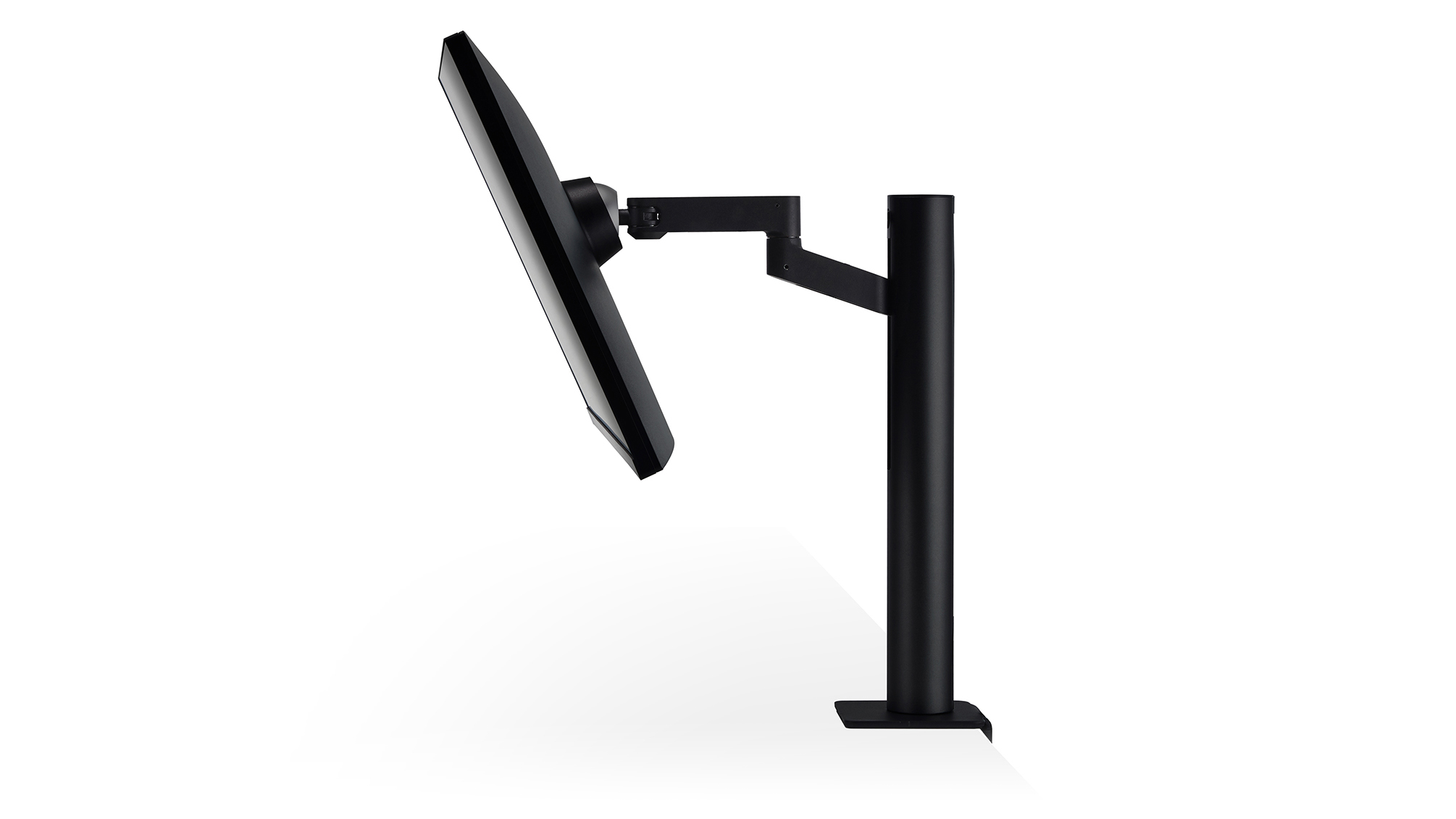LG Ergo 27QN880-B review: Stand and under-deliver
It stands out, but you know you’re in trouble when you love a monitor’s ergonomics more than its panel

-
+
Flexible and convenient stand
-
+
Great sRGB colour accuracy
-
+
Capable selection of ports
-
-
Woeful OSD
-
-
Disappointing DCI-P3 coverage
-
-
No speakers

In a world of identikit 27in 1440p panels, you need something special to (ahem) stand out from the crowd, and LG takes the interesting approach of shipping the Ergo 27QN880-B with a flexible arm rather than a conventional stand.
And it really is flexible. We’re reminded of the 1960s classic song Bend Me, Shape Me, because you can push the Ergo 27QN880 any way you want to (it’s alright). It has all the moves too, whether you want to move it to the left or take a step to the right. You can pivot it, push it all the way to the back of your desk, or adjust it to almost any height. You can tilt it back by 25°, or forwards the same distance. This makes it blissfully easy to push the monitor away when you don’t want it, and also bring it up close when you need to.
Those in the know will correctly point out that you can buy a third-party monitor arm for around £30, but these are unlikely to offer the same smooth motion and level of build quality as the supplied LG apparatus. Setting them up will also be more fiddly; we needed to adjust the base position of the LG’s clamp due to the shallowness of our desk, but that took two minutes and a crosshead screwdriver. There are also benefits to choosing an arm that’s custom-fitted for your monitor, not least the fact that it clicks into place with zero fuss, whereas with a third-party arm, you’ll need to attach it using a VESA mount.
All that said, you would be right to point out that £365 is a lot for a 1440p monitor that, in truth, doesn’t have any other standout features. This is a pleasant 8-bit IPS panel, but the only claims LG makes regarding its colour performance are that it covers 99% of the sRGB gamut and supports HDR 10.
Our usual array of tests quickly confirmed the first claim. Even in its default setting, it covered 98.4% of the sRGB gamut out of a 106.9% volume, while tweaking its colour balance pushed those figures to 99.6% and 111.6%. You can trust the colour accuracy too, with an average Delta E of 0.48 in our tests. Those are fine results.

Gamers are less likely to be impressed by this panel’s peak refresh rate of 75Hz and 5ms response times, but LG throws them a lifeline with support for AMD’s FreeSync 2 adaptive sync technology. Theoretically, with HDR 10 support and a peak measured brightness of 390cd/m2, it’s better suited to watching TV and films – but this monitor wouldn’t be our top choice for those activities. That’s in part due to a lowly measured contrast ratio of 865:1 (lower than LG’s stated 1,000:1), but mainly because it covers a modest 79.9% of the DCI-P3 colour space favoured by the film industry. Also note that this model, with a “-B” suffix, doesn’t include the two 5W speakers you may see on LG’s promotional page for the 27QN880.
Keen photographers and filmmakers should also look elsewhere, because 75% coverage of the Adobe RGB colour space means you’ll miss out on some precious greens and blues. All this doesn’t make the LG Ergo a bad display – remember its excellent sRGB coverage – but this isn’t a panel for the colour connoisseur.
Instead, this is a screen built for convenience, and LG hammers home that advantage through its selection of inputs. Top of the list is USB-C, with 60W of power delivery enough to feed the vast majority of laptops. There are two USB-A ports at the rear, but note there isn’t a USB-B upstream port so you’ll only be able to use these when connected over USB-C. What you will find is two HDMI ports, a DisplayPort input and a 3.5mm jack for headphones.
LG’s carefully arranged product photos won’t show you the need for an external power supply, which ruins the clean lines of a desk unless you can find somewhere else to store it. LG has thought about cable management, though, with space in the main stand to slide them through before their final journey to the rear of the monitor.
We only wish that LG had paid similar attention to the awful OSD, which is far too sluggish for a professional display. It relies on a multi-directional button tucked into the bottom of the front bezel, and slow processing combined with a lack of definition (did we press forward correctly, or was it too much to the right?) meant we often found ourselves in a frustrating limbo.
This is a shame, as with the right execution – and a wider-gamut panel – this could have been a monitor that truly stood out from the rest. Ultimately, the LG Ergo 27QN880-B only serves as an advert for the many benefits of an arm stand.
LG Ergo 27QN880-B specifications
| Screen size | 27in |
| Screen resolution | 2,560 x 1,440 |
| Screen technology | IPS panel |
| Screen refresh rate | 75Hz maximum refresh rate |
| Video inputs | DisplayPort (HDCP 1.4a), 2 x HDMI, USB-C (power delivery 60W) |
| Audio inputs/outputs | 3.5mm headphone jack |
| Speakers | N/A |
| Ports | 2-port USB hub |
| Adjustability | LG Ergo stand with -140°/140° swivel, pivot, -25°/25° tilt, 130mm height adjustment |
| Dimensions | 614 x 45 x 364mm (without stand) |
| Weight | 4.8kg (without stand) |
| Warranty | 2yr warranty |
Get the ITPro daily newsletter
Sign up today and you will receive a free copy of our Future Focus 2025 report - the leading guidance on AI, cybersecurity and other IT challenges as per 700+ senior executives
Tim Danton is editor-in-chief of PC Pro, the UK's biggest selling IT monthly magazine. He specialises in reviews of laptops, desktop PCs and monitors, and is also author of a book called The Computers That Made Britain.
You can contact Tim directly at editor@pcpro.co.uk.
-
 ‘Phishing kits are a force multiplier': Cheap cyber crime kits can be bought on the dark web for less than $25 – and experts warn it’s lowering the barrier of entry for amateur hackers
‘Phishing kits are a force multiplier': Cheap cyber crime kits can be bought on the dark web for less than $25 – and experts warn it’s lowering the barrier of entry for amateur hackersNews Research from NordVPN shows phishing kits are now widely available on the dark web and via messaging apps like Telegram, and are often selling for less than $25.
By Emma Woollacott Published
-
 Redis unveils new tools for developers working on AI applications
Redis unveils new tools for developers working on AI applicationsNews Redis has announced new tools aimed at making it easier for AI developers to build applications and optimize large language model (LLM) outputs.
By Ross Kelly Published
-
 Google layoffs continue with "hundreds" cut from Chrome, Android, and Pixel teams
Google layoffs continue with "hundreds" cut from Chrome, Android, and Pixel teamsNews The tech giant's efficiency drive enters a third year with devices teams the latest target
By Bobby Hellard Published